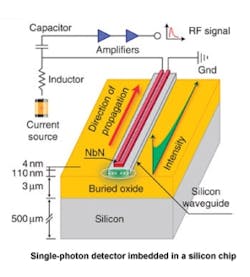Superconducting nanowire single-photon detector has near-unity detection efficiency
Karlsruhe, Germany--A single-photon detector that combines near-unity detection efficiency with high timing resolution and a very low error rate has been created by researchers at the Karlsruhe Institute of Technology (KIT), Yale University, Boston University, and Moscow State Pedagogical University.1 The group achieved this by integrating superconducting nanowire detectors on top of nanophotonic waveguides to greatly increase the absorption length for incoming photons.
The single-photon detection efficiency reaches up to 91% at a 1550 nm wavelength, a number that was consistent across several fabricated chips. The new design also provides ultrashort timing jitter of 18 ps. Such qualities, along with a dark-count rate as low as 50 Hz, make this integrated detector a prime candidate for optical data transmission and quantum computation.
The fabrication method makes it possible to integrate several hundreds of these detectors on a single chip (a basic precondition for future use in optical quantum computers). The same detector architecture could also be used for wavelengths in the range of visible light.
REFERENCE:
1. W. H. P. Pernice et al., Nature Communications, (27 December 2012), doi:10.1038/ncomms2307

John Wallace | Senior Technical Editor (1998-2022)
John Wallace was with Laser Focus World for nearly 25 years, retiring in late June 2022. He obtained a bachelor's degree in mechanical engineering and physics at Rutgers University and a master's in optical engineering at the University of Rochester. Before becoming an editor, John worked as an engineer at RCA, Exxon, Eastman Kodak, and GCA Corporation.
